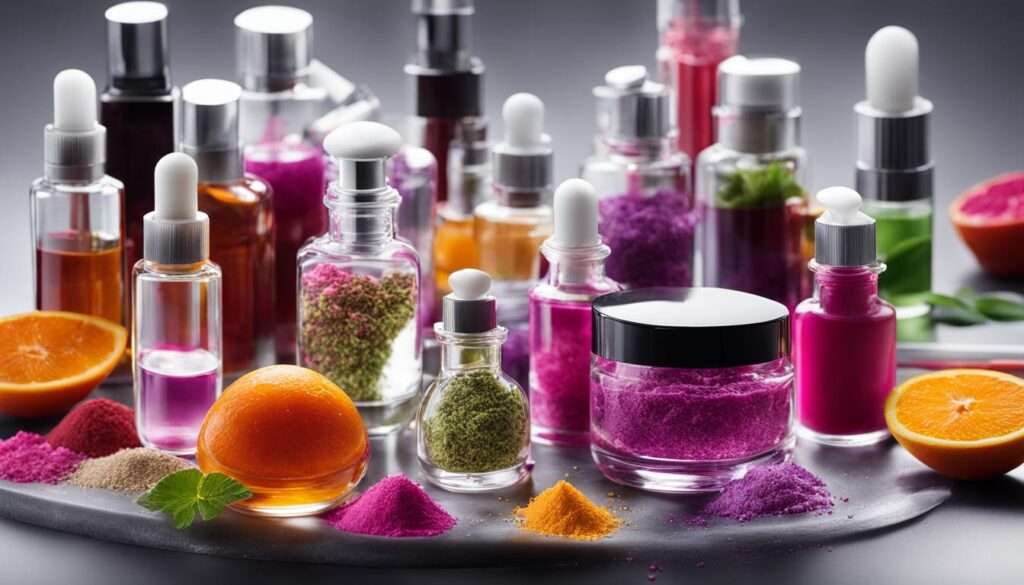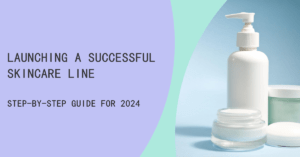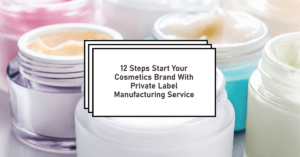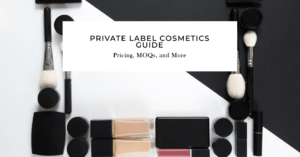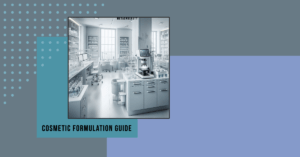The cosmetic formulation process is a complex and intriguing combination of science and art. It involves the creation of beauty products that enhance and innovate our daily routines. From selecting the right ingredients to following specific steps and techniques, this process requires careful planning and attention to detail. In this article, we will explore the secrets behind the cosmetic formulation process and uncover the steps involved in developing successful cosmetic products.
The Importance of Cosmetic Ingredients
One of the key elements of the cosmetic formulation process is the selection of ingredients. The choice of ingredients plays a crucial role in determining the effectiveness and quality of the final product. Formulators must consider the specific properties and benefits of each ingredient, as well as their compatibility and stability within the formulation. Whether it’s natural extracts, synthetic compounds, or a combination of both, careful ingredient selection is essential to create safe and high-performance cosmetic products.
The Guiding Principles of Cosmetic Formulation
When developing cosmetic products, formulators rely on a set of guiding principles and techniques to ensure the creation of safe and effective formulations. These principles take into consideration various factors, such as pH balance, emulsion stability, viscosity, and shelf life. By following these guidelines and utilizing different formulation techniques and methods, formulators are able to achieve the desired texture, stability, and efficacy in their cosmetic products.
There are several key principles that formulators consider during the cosmetic formulation process:
- pH balance: Maintaining the correct pH balance is crucial to ensure the stability and effectiveness of cosmetic products. Different ingredients require specific pH levels for optimal performance, and formulators carefully adjust the formulation to achieve the desired balance.
- Emulsion stability: Emulsions, such as creams and lotions, consist of two or more immiscible substances, such as water and oil. Achieving and maintaining stability in these formulations is essential to prevent phase separation or breakdown. Formulators employ techniques such as emulsifier selection, homogenization, and temperature control to ensure stable emulsions.
- Viscosity: Viscosity refers to the thickness or flowability of a cosmetic product. It plays a crucial role in user experience and product performance. Different products require different viscosities, and formulators use ingredients and techniques to adjust viscosity levels, such as the inclusion of thickeners or adjustment of formulation temperature.
- Shelf life: Ensuring that cosmetic products have an adequate shelf life is important to maintain their quality and efficacy over time. Formulators consider factors such as microbial growth, oxidation, and ingredient stability when determining the appropriate preservatives and antioxidants to include in the formulation.
Industry guidelines and regulations also play a significant role in cosmetic formulation. These guidelines ensure product safety and compliance with regulatory standards. Formulators adhere to these guidelines in terms of ingredient restrictions, labeling requirements, and manufacturing practices. By following these guidelines and staying up-to-date with the latest regulations, formulators can ensure that their formulations meet the necessary legal and safety standards.
Overall, the guiding principles of cosmetic formulation provide formulators with a framework to develop high-quality products that deliver the desired results. By considering factors such as pH balance, emulsion stability, viscosity, and shelf life, as well as adhering to industry guidelines, formulators can create safe and effective cosmetic formulations that meet consumer expectations.
The Step-by-Step Process of Cosmetic Formulation
The cosmetic formulation process is a meticulously planned and executed journey, comprising several key steps. In this section, we will delve into the intricacies of the formulation process, from the initial research and concept development phase to the final manufacturing and distribution of the product.
Step 1: Research and Concept Development
Every successful formulation begins with thorough research and concept development. Formulators extensively analyze market trends, consumer preferences, and specific product requirements. This meticulous understanding helps shape the formulation and ensures it aligns with the target audience’s needs.
Step 2: Ingredient Selection and Formulation Development
Once the research phase is complete, formulators move on to ingredient selection and formulation development. They carefully choose ingredients that possess the desired properties, functionality, and efficacy for the final product. The perfect balance of ingredients is crucial to achieve the desired cosmetic benefits.
During the formulation development stage, formulators combine the selected ingredients in precise ratios. They follow specific formulation techniques and consider factors such as pH balance, emulsion stability, texture, and desired performance. This attention to detail ensures the formulation is effective, safe, and appealing to consumers.
Step 3: Stability, Safety, and Efficacy Testing
After formulating the product, the next step involves testing its stability, safety, and efficacy. Various laboratory and consumer trials are conducted to ensure that the formulation meets the required standards. Stability testing assesses the formulation’s ability to withstand various conditions, such as temperature changes and UV exposure, over an extended period.
Safety testing focuses on evaluating potential skin irritations, sensitization, and allergic reactions. Efficacy testing measures the product’s effectiveness in delivering the intended benefits, such as moisturization, anti-aging properties, or UV protection. These tests are crucial to validate the formulation’s performance and ensure customer satisfaction.
Step 4: Manufacturing, Packaging, and Distribution
After successfully formulating and testing the product, it moves into the manufacturing phase. Manufacturers carefully follow the precise formula created by formulators, ensuring consistency and quality during production. Once manufactured, the product is packaged according to aesthetic and functional considerations.
Careful attention is given to packaging design, material selection, and branding, as it plays a vital role in attracting consumers and communicating the product’s essence. Finally, the product is ready for distribution, whether through retail stores, online platforms, or professional networks.
This step-by-step approach ensures that the cosmetic formulation process is thorough, meticulous, and results in high-quality products that cater to the needs and desires of consumers.
Quality Control and Testing in Cosmetic Formulation
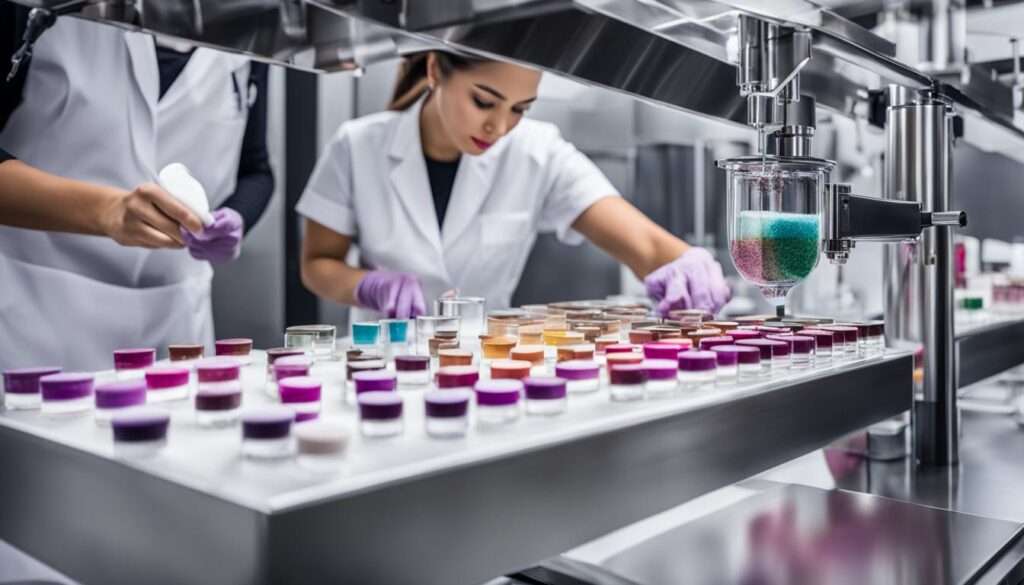
Quality control and testing are crucial aspects of the cosmetic manufacturing process. Manufacturers follow strict protocols to ensure that each batch of cosmetic products meets the necessary safety, efficacy, and quality standards. By conducting rigorous testing at different stages, they can guarantee the safety and effectiveness of their formulations.
During the cosmetic manufacturing process, quality control and testing include:
- Testing of raw materials: All ingredients used in cosmetic formulations undergo thorough testing to ensure their purity, stability, and compatibility. This step is essential to eliminate any potential risks or contaminants that may compromise the quality of the final product.
- In-process testing: Manufacturers conduct regular inspections and evaluations throughout the manufacturing process to monitor the quality and consistency of the cosmetic product. This helps identify any deviations from the desired formulation, enabling prompt corrective actions.
- Final product testing: Once the manufacturing process is complete, the final cosmetic products undergo extensive testing to assess their safety, stability, and performance. These tests include stability testing, microbial testing, and product performance testing, among others.
Stability testing evaluates the physical and chemical properties of the cosmetic formulation over time. It ensures that the product remains stable, maintains its effectiveness, and does not degrade under various storage conditions.
Microbial testing assesses the presence of harmful microorganisms in the cosmetic product. These tests are vital to ensure that the product is free from bacterial, fungal, or other microbial contamination, ensuring consumer safety.
Product performance testing involves evaluating how the cosmetic product performs its intended function. It includes testing for attributes such as texture, appearance, fragrance, and effectiveness in delivering the desired beauty benefits.
Overall, quality control and testing play a crucial role in the cosmetic manufacturing process, ensuring that every product that reaches the market is safe, effective, and of the highest quality.
Key Takeaways:
– Quality control and testing are integral parts of the cosmetic manufacturing process.
– Testing of raw materials, in-process testing, and final product testing are key aspects of quality control.
– Stability testing, microbial testing, and product performance testing are essential for ensuring the safety and effectiveness of cosmetic products.
Now, let’s take a closer look at the specific tests conducted during the cosmetic manufacturing process:
| Test Type | Purpose |
|---|---|
| Raw Material Testing | To ensure the purity, stability, and compatibility of cosmetic ingredients |
| In-Process Testing | To monitor the quality and consistency of the cosmetic product during manufacturing |
| Final Product Testing | To assess the safety, stability, and performance of the finished cosmetic product |
| Stability Testing | To evaluate the product’s physical and chemical properties over time |
| Microbial Testing | To detect and eliminate any microbial contamination in the cosmetic product |
| Product Performance Testing | To assess the cosmetic product’s effectiveness in delivering the desired beauty benefits |
Innovations in Cosmetic Formulation

The field of cosmetic formulation is continuously evolving with new technologies and innovative approaches driving product development. Formulators are exploring novel ingredients, formulation techniques, and delivery systems to create groundbreaking cosmetic products that meet the ever-changing needs and expectations of consumers.
Exploring Cutting-Edge Ingredients
Formulators are constantly on the lookout for innovative ingredients that offer unique properties and benefits. Whether it’s natural extracts, advanced active compounds, or bioengineered substances, these cutting-edge ingredients are revolutionizing cosmetic formulations. By incorporating these ingredients, formulators can create products that deliver exceptional results and cater to specific skincare concerns.
Advancements in Formulation Techniques
Formulation techniques play a vital role in creating safe and effective cosmetic products. With advancements in technology, formulators now have access to sophisticated techniques that enhance product performance. Techniques like microencapsulation, nanotechnology, and emulsion stabilization have given rise to new possibilities, improving the stability, efficacy, and sensory attributes of cosmetic formulations.
Revolutionary Delivery Systems
Delivery systems have taken cosmetic formulations to the next level. From time-release mechanisms to targeted delivery, these innovative systems ensure that active ingredients reach their intended destination for maximum efficacy. By encapsulating ingredients, formulators can protect them from degradation and enhance their absorption, unlocking new opportunities for skincare and treatment products.
These innovations drive formulators to push boundaries, challenging traditional cosmetic formulation principles and techniques to create products that push the limits of performance and efficacy.
The Role of Technology and Data in Formulation
Technology plays a crucial role in cosmetic formulation innovations. Advanced equipment and software help formulators analyze and optimize formulations, ensuring their stability and effectiveness. Additionally, data-driven insights obtained through research and consumer feedback enable formulators to develop products tailored to specific demographics and target groups.
The Future of Cosmetic Formulation
The future of cosmetic formulation holds immense potential. As technologies continue to evolve, formulators will have access to even more advanced tools and ingredients for product development. With an emphasis on sustainability, personalization, and performance, the beauty industry is poised to witness a new era of cosmetic formulations that cater to individual needs while prioritizing environmental responsibility.
| Innovation | Description |
|---|---|
| Novel Ingredients | New and unique ingredients that offer enhanced benefits and address specific skincare concerns. |
| Advanced Formulation Techniques | Sophisticated techniques like microencapsulation and nanotechnology, improving stability and efficacy. |
| Revolutionary Delivery Systems | Innovative systems ensuring targeted and optimized delivery of active ingredients for maximum efficacy. |
| Role of Technology and Data | Technology-driven formulation optimization and data-driven insights for personalized product development. |
The Art of Packaging in Cosmetic Formulation
Packaging plays a crucial role in the success of cosmetic products. It not only protects the formulation but also serves as a marketing tool, attracting consumers and conveying the brand’s image. Packaging design, materials, and functionality are carefully considered during the formulation process. Formulators collaborate with packaging experts to create packaging solutions that are aesthetically pleasing, practical, and environmentally friendly.
When it comes to cosmetic product packaging, the design is just as important as the product itself. A visually appealing packaging design can capture the attention of consumers and create a positive first impression. It can also communicate the brand’s values, target audience, and product benefits effectively.
The packaging materials used in cosmetic formulation should not only be visually appealing but also functional and safe. Formulators consider factors such as product compatibility, stability, and shelf life when selecting packaging materials. They also assess the sustainability and environmental impact of the chosen materials to align with the growing consumer demand for eco-friendly packaging options.
Additionally, packaging plays a crucial role in preserving the quality and efficacy of the cosmetic formulation. It must protect the product from external factors such as light, air, and moisture, which can degrade the formulation over time. This is especially important for products that contain sensitive or active ingredients.
Formulators collaborate with packaging experts who have in-depth knowledge about various packaging materials, design trends, and industry regulations. Together, they work to create packaging solutions that not only enhance the product’s appeal on the shelf but also ensure its integrity and longevity.
Sustainable Practices in Cosmetic Formulation
As the demand for sustainable and eco-friendly products grows, the cosmetic formulation process is also adapting to incorporate sustainable practices. Formulators are exploring the use of renewable and biodegradable ingredients, as well as eco-friendly packaging materials. They are also implementing energy-efficient manufacturing processes and reducing waste generation. By embracing sustainable practices, the cosmetic industry can contribute to a greener and more responsible future.
In the pursuit of sustainable cosmetic formulation, formulators strive to minimize the environmental impact of their products. This involves carefully selecting ingredients that are sourced sustainably and have minimal negative effects on the environment. Examples of eco-friendly ingredients include organic plant extracts, biodegradable surfactants, and natural emollients.
Eco-friendly packaging plays a vital role in sustainable formulation. Formulators are opting for recyclable and biodegradable packaging materials to reduce waste accumulation. They also consider innovative packaging designs that minimize material usage and optimize product preservation.
“Sustainable cosmetic formulation practices prioritize the use of renewable resources and the reduction of energy consumption and waste generation.”
In addition to ingredient and packaging choices, energy-efficient manufacturing processes are being adopted to minimize carbon emissions and conserve resources. Formulators optimize production methods to reduce energy consumption and implement waste management strategies to minimize environmental impact.
By embracing sustainable practices in cosmetic formulation, the industry can contribute to a greener and more responsible future. Consumers are becoming increasingly conscious of the environmental impact of their choices and are actively seeking eco-friendly alternatives. The shift towards sustainable cosmetic products not only benefits the planet but also provides consumers with ethical and environmentally conscious options.
Benefits of Sustainable Cosmetic Formulation
The adoption of sustainable practices in cosmetic formulation brings several benefits:
- Environmental Responsibility: By choosing eco-friendly ingredients and packaging materials, cosmetic companies reduce their carbon footprint and contribute to the preservation of natural resources.
- Consumer Appeal: Sustainable cosmetic products resonate with environmentally conscious consumers, who are more likely to choose products that align with their values.
- Brand Differentiation: Companies that prioritize sustainability can stand out in the market, attracting consumers who prioritize ethical and environmentally friendly choices.
- Industry Leadership: By leading the way in sustainable practices, cosmetic formulators can influence other industries to adopt more eco-friendly approaches, creating a ripple effect for positive change.
Sustainable Formulation in Action
Many cosmetic brands have already embraced sustainable formulation practices and are making a positive impact on the environment:
| Brand | Sustainable Practices |
|---|---|
| 1. The Body Shop | Uses sustainably sourced natural ingredients, promotes fair trade, and actively fights against animal testing. |
| 2. Lush | Focuses on packaging-free products, uses minimal packaging made from recycled materials, and supports environmental campaigns. |
| 3. Fenty Beauty | Strives for inclusivity, transparency, and sustainability, using recyclable packaging materials and prioritizing cruelty-free and vegan formulations. |
These brands serve as an inspiration for the cosmetic industry, showcasing that sustainable practices are not only feasible but also commercially successful.
As consumer demand for sustainable and eco-friendly products continues to rise, cosmetic formulation must continue to evolve and prioritize sustainability. By embracing renewable and biodegradable ingredients, eco-friendly packaging, and energy-efficient manufacturing processes, cosmetic companies can make a significant positive impact on the environment while meeting consumer expectations for ethical and environmentally conscious choices.
Regulatory Compliance in Cosmetic Formulation
Ensuring product safety and consumer protection is of paramount importance in the cosmetic formulation process. Various regulations and guidelines have been established to govern the development and manufacturing of cosmetic products. Compliance with these regulations is crucial to prevent legal issues and to maintain the integrity and trust of the industry.
Regulatory bodies, such as the Food and Drug Administration (FDA), play a vital role in setting standards for cosmetic ingredients, labeling requirements, and manufacturing practices. These standards encompass aspects such as the safety and efficacy of ingredients, accurate product labeling, and adherence to good manufacturing practices.
Formulators must stay up-to-date with the latest cosmetic formulation regulations to ensure compliance. This involves keeping track of any changes or new requirements introduced by regulatory bodies. Failure to comply with these regulations can lead to severe consequences, including product recalls, fines, and even legal actions.
To navigate the complex landscape of regulatory compliance, formulators often collaborate with regulatory experts, consultants, or legal professionals who specialize in the field. These experts provide guidance and assistance in understanding and implementing the necessary requirements for cosmetic formulation safety.
By working closely with regulatory experts and staying abreast of cosmetic formulation regulations, formulators can confidently develop and market cosmetic products that meet the highest safety and quality standards. In doing so, they ensure the well-being and satisfaction of consumers while maintaining the integrity of the cosmetic industry as a whole.
Challenges and Future Trends in Cosmetic Formulation
The cosmetic formulation process comes with its fair share of challenges that formulators must tackle to create successful beauty products. From sourcing ingredients to ensuring formulation stability and optimizing costs, formulators face numerous obstacles along the way. Additionally, they must constantly adapt to changing consumer preferences and market trends to remain competitive in the beauty industry. Despite these challenges, the future of cosmetic formulation is bright, with exciting trends and innovations on the horizon.
Looking ahead, the cosmetic formulation industry is poised to embrace new technologies that revolutionize product development. Advancements in areas such as artificial intelligence, biotechnology, and 3D printing are set to reshape the way cosmetic products are formulated and manufactured. These technologies offer opportunities for personalized beauty solutions and the creation of highly tailored products that cater to individual needs and desires.
The growing focus on sustainability is another driving force in the future of cosmetic formulation. Consumers are increasingly demanding eco-friendly products, and formulators are implementing sustainable practices throughout the formulation process. They are exploring the use of renewable and biodegradable ingredients, reducing waste generation, and opting for eco-friendly packaging solutions. Sustainability is not only a trend but also a necessity for the cosmetic industry to contribute to a greener and more responsible future.
In addition to sustainability, there is a rising demand for clean beauty products that are free from harmful ingredients. Consumers are becoming more conscious about the impact of cosmetic products on their health and the environment. As a result, formulators are striving to develop formulations that are clean, safe, and transparent in their ingredient choices. This trend towards clean beauty is expected to continue, with formulators focusing on creating products that align with consumer values and meet their growing expectations.
“The future of cosmetic formulation lies in the convergence of science, technology, and consumer needs. As the beauty industry continues to evolve, formulators must stay agile and innovative, anticipating and meeting the ever-changing demands of consumers.”
Key Trends in Cosmetic Formulation:
- Integration of advanced technologies like artificial intelligence, biotechnology, and 3D printing
- Growing focus on sustainability and eco-friendly practices
- Rise of clean beauty and transparency in ingredient choices
- Customization and personalized beauty solutions
- Exploration of new and unique ingredients for innovative formulations
By addressing the challenges and embracing these future trends, formulators can navigate the ever-changing landscape of cosmetic formulation and continue to innovate and delight consumers with safe, effective, and sustainable beauty products.
Collaborations and Partnerships in Cosmetic Formulation
Collaboration and partnership are key drivers of innovation in the cosmetic formulation industry. Formulators recognize the value of working together with ingredient suppliers, research institutions, and other experts to access cutting-edge technologies and expertise. These collaborations provide formulators with the opportunity to create unique and high-performance cosmetic products that meet the evolving needs of consumers.
By pooling resources and leveraging the strengths of different stakeholders, the cosmetic formulation process can achieve greater success. Collaborative efforts foster creativity, encourage knowledge-sharing, and allow for the exploration of new ideas and approaches. Through these collaborations, formulators can stay at the forefront of cosmetic product development, delivering innovative solutions that captivate consumers.
“Collaboration is the key to unlocking the endless possibilities in cosmetic formulation. By working together, formulators can push the boundaries of creativity and scientific advancement to develop products that truly stand out in the market.”
Partnerships with ingredient suppliers bring access to a diverse range of raw materials and expertise. Researchers and scientists contribute their specialized knowledge and cutting-edge research findings, enriching the formulation process. This collaborative ecosystem fuels innovation and drives the development of cosmetic products that meet the ever-changing demands of consumers.
Benefits of Collaborations and Partnerships
- Access to advanced technologies and research findings
- Diversification of ingredient options
- Pooling of resources and expertise
- Accelerated development timelines
- Innovation through the exchange of ideas and perspectives
Collaborations and partnerships in cosmetic formulation exemplify the industry’s commitment to continuous improvement and staying ahead of market trends. These strategic alliances enable formulators to tap into a vast network of knowledge and resources, resulting in the creation of cosmetic products that are truly exceptional.
Whether it’s a collaboration with an ingredient supplier, a partnership with a research institution, or a joint venture with another brand, these collaborative efforts pave the way for groundbreaking cosmetic formulations.
Conclusion
The cosmetic formulation process is an intricate blend of science, art, and innovation that aims to create safe, effective, and high-quality cosmetic products. Formulators meticulously select the right ingredients and follow specific steps and techniques to bring their creations to life. By embracing sustainability, adhering to regulations, and collaborating with industry experts, the future of cosmetic formulation looks promising.
As consumers increasingly seek beauty products that enhance their well-being, the cosmetic formulation process will continue to evolve. From natural extracts to advanced active ingredients, formulators are constantly pushing the boundaries of innovation in the beauty industry. They are also incorporating sustainable practices, such as using renewable and biodegradable ingredients, to meet the growing demand for eco-friendly products.
Compliance with regulatory standards is crucial in the cosmetic formulation process. Formulators ensure that their products meet safety guidelines and fulfill the necessary requirements for market entry. By working closely with regulatory experts, they navigate the complex landscape of cosmetic formulation regulations, ensuring that their formulations remain compliant with industry standards.
Overall, the cosmetic formulation process combines the precision of science with the creativity of art, resulting in effective and innovative cosmetic products. As the industry continues to progress, the future holds exciting possibilities for formulators and consumers alike.
FAQ
What is the cosmetic formulation process?
The cosmetic formulation process is the combination of science and art involved in creating beauty products. It includes ingredient selection, following specific steps and techniques, and adhering to industry guidelines to develop successful cosmetic products.
How important is ingredient selection in the cosmetic formulation process?
Ingredient selection is crucial in determining the effectiveness and quality of cosmetic products. Formulators must consider the properties, benefits, compatibility, and stability of each ingredient to create safe and high-performance formulas.
What principles and techniques guide the cosmetic formulation process?
The cosmetic formulation process is guided by principles such as pH balance, emulsion stability, viscosity, and shelf life. Formulators follow specific techniques and adhere to industry guidelines and regulations to achieve the desired texture, stability, and efficacy in their products.
What are the steps involved in the cosmetic formulation process?
The cosmetic formulation process typically involves research and concept development, ingredient selection, formulation development, stability and safety testing, and finally, manufacturing and packaging.
How important is quality control and testing in cosmetic formulation?
Quality control and testing are integral to ensure that cosmetic products meet safety, efficacy, and quality standards. Manufacturers rigorously test raw materials, in-process samples, and final products for stability, microbial safety, and performance.
What innovations are emerging in cosmetic formulation?
Cosmetic formulation is embracing new technologies and innovations such as encapsulation technology and advanced active ingredients. These advancements are revolutionizing the beauty industry and offering consumers innovative and effective skincare and beauty solutions.
What role does packaging play in the cosmetic formulation process?
Packaging protects the formulation and serves as a marketing tool to attract consumers and convey the brand’s image. Packaging design, materials, and functionality are considered during the formulation process to create aesthetically pleasing, practical, and environmentally friendly packaging solutions.
How does sustainability factor into the cosmetic formulation process?
The cosmetic formulation process is adapting to incorporate sustainable practices. Formulators are exploring the use of renewable and biodegradable ingredients, eco-friendly packaging materials, energy-efficient manufacturing, and waste reduction to contribute to a greener future.
What regulations are involved in the cosmetic formulation process?
The cosmetic formulation process must adhere to regulations set by regulatory bodies such as the FDA. These regulations cover cosmetic ingredients, labeling, and manufacturing practices to ensure product safety and consumer protection.
What are the challenges and future trends in cosmetic formulation?
Formulators face challenges such as ingredient sourcing, formulation stability, and cost optimization. Future trends in cosmetic formulation include incorporating new technologies, sustainability practices, and personalized beauty solutions to meet evolving consumer demands.
What role do collaborations and partnerships play in cosmetic formulation?
Collaboration and partnership are essential in the cosmetic formulation industry. Formulators collaborate with ingredient suppliers, research institutions, and other experts to access cutting-edge technologies and expertise, fostering innovation and creating unique cosmetic products.
What is the future of the cosmetic formulation process?
The cosmetic formulation process continues to evolve to meet consumer demands. By embracing new technologies, sustainability practices, and personalized beauty solutions, the cosmetic industry holds great promise in delivering innovative and effective cosmetic products.
